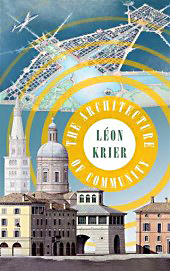A Placemaking Journal
What We’re Reading: Leon Krier’s “Architecture of Community”
In 1984, Bruce Springsteen told Rolling Stone Magazine that he had albums of unreleased songs and that one day he would “put those out because there was good material in there.” In 1998, he did just that, releasing a beautiful 4-disc set of unreleased songs. Being a long-time devotee, I was more than a little impressed that, though it took fifteen years, I could still count on Springsteen to keep his word.

A "handy publication" indeed.
During a 2003 charrette, as I asked Mr. Leon Krier to sign my well-worn copy of Architecture: Choice or Fate (Andreas Papadakis Publisher, 1998), he noted that he hadn’t seen too many of his books in the States. In my lame attempt to impress Mr. Krier (no, I didn’t tell him I was a Springsteen fan) I told him that my copy had been found at Powell’s Book Store in Portland and I then began to recite my complete collection of Leon Krier books–L.K. Houses, Palaces, Cities (Academy, 1984) and Rational Architecture (AAM, 1978)–and where I had found them. Mr. Krier gently interrupted me to say something about the need for a “handy publication of my architectural and planning ideas.”
As quoted from the book’s Author’s Note above, Mr. Krier has kept to his word and done just that. The Architecture of Community is a seamless read and a comprehensive publication of his architectural and planning ideas crafted over 40 years. The 443 pages read quickly, as more than half of the book is filled with his poignant cartoons, vignettes, and parti. Eagerly, I read the book over the weekend, trying to not bend the corners or dint the dust jacket.
However, the book’s pristine condition will not last, as I have already begun to use the book as my primary reference guide for architecture and urban composition and theory. I tend to view my daily professional life as tilting at windmills of conventional architecture and urban design, and Mr. Krier’s pithy cartoons lighten this perception, both literally and figuratively. This book contains well-known images from past books as well as new images, photographs, projects, observations and captions.
A missed opportunity in the book is any direct reference to his polemic and inspirational debates with Peter Eisenmann in 1983, which were summed up with this barb, “You can’t, but I can,” in response to Peter stating, “Leon, come on, you cannot build this way anymore today!” Understanding that Mr. Krier’s theoretical position is detailed throughout the book, those series of debates, in my opinion, helped to shape what design means to the United States of America.
As discussed in his chapter, The Modernity of Traditional Architecture, “Traditional architectural forms derive from and are conditioned by the use of natural materials.” Today, with sustainability having moved from long-time trend status (such as Watershed Planning and Livable Communities) to radical movement (such as Modernism and New Urbanism), Mr. Krier’s long-time focus on ecological planning and humane buildings is rising up to meet our contemporary needs.
The book is published by Island Press (ISBN-13:978-1-59726-578-2). Through simple, matter-of-fact, black and white text and graphics, it comprehensively illustrates how Mr. Krier’s work has consistently delved deeper into the timelessness of building “good and elegant human settlements” with new chapters (The Architectural Tuning of Settlements) assembled upon the old (Aspects of Modernity). And, his steady, reliable, dependable and honest focus on shaping our buildings, neighborhoods and towns towards an architecture and urbanism that are simply beautiful is to be celebrated with the reading of Leon Krier’s new book.
– Howard Blackson

